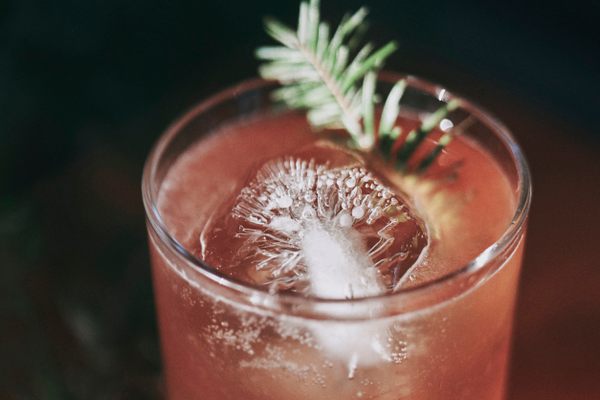How to Eat or Drink Your Christmas Tree
Don’t just throw out your tree; use it to spruce up your cocktails, stews, and more.
THIS ARTICLE IS ADAPTED FROM THE JANUARY 6, 2024, EDITION OF GASTRO OBSCURA’S FAVORITE THINGS NEWSLETTER. YOU CAN SIGN UP HERE.
The week between Christmas and New Year’s is meant for relaxing and moving slowly. It’s a time of consuming leftovers and gradually cleaning up holiday detritus that’s collected around your home. Last week, I did a bit of both by transforming my Christmas tree into a cocktail.
The recipe I used is by Julia Georgallis, author of How to Eat Your Christmas Tree. In her article for Gastro Obscura, Georgallis discusses many ways to deliciously repurpose the spruce, fir, or pine still lurking in your living room each January. Her recipes range from Christmas tree–cured fish to spruce-and-ginger ice cream to apple-and-fir membrillo.
I started by plucking the needles off my balsam fir, tinting my fingers dark and scenting them with the aroma of pine. When I had about 200 grams, I simmered the needles with lemon and sugar. Surprisingly, the resulting cordial wasn’t green at all, but a warm pink. With some prosecco and lemon, it made for a rosy, floral mimosa. I found the cordial’s sharp, grassy flavor overwhelmed the prosecco a bit, so I also tried just a few splashes in a glass of ginger ale, whose sweetness countered the piney earthiness well.
Sipping on O Tannenbaum may sound like a novel idea, but people have been consuming tree-derived foods and drinks for millennia. This week, we’re looking at how different cultures transform bark, needles, and even pine cones into everything from beer to bread to jelly.
Spruce Beer

In his 1784 Voyage to the Pacific Ocean, Captain James Cook describes two men who had a very important responsibility: brewing the crew’s spruce beer. “Such a regimen,” he notes, “soon removed all seeds of the scurvy from our people.”
The nutritional appeal of spruce beer wasn’t limited to explorers: Everyone from Vikings to Indigenous groups of North America have turned to boiling and sometimes fermenting tree tips into a piney brew.
Captain Cook would be disappointed to learn that modern scholars have learned that spruce beer does little to battle scurvy (boiling or fermenting spruce tips reduces their vitamin C). But the drink remains popular in certain regions. While it’s hard to track down in the United States, there are several companies producing both alcoholic and nonalcoholic spruce beers in Canada.
Pine Bark Bread

Among the Samí people—an Indigenous group in northern Scandinavia—transforming bark into bread is an ancient art. Pine bark bread, or pettuleipä, is made by drying and pounding the pine tree’s inner layer of bark (known as phloem) until it becomes a flour.
Today, pine bark bread is a simple food that’s unlikely to spark any sourdough-esque TikTok crazes. But its popularity has spiked during times of scarcity: Finns turned to pettuleipä during a two-year famine in the 1500s and supplemented their meager flour supplies with bark-derived varieties during wartime rationing in the 1900s.
Traditional bark bread once contained more than 50 percent bark meal blended with wheat flour. This tends to be a bit too bitter and fibrous for modern diners, who typically use a ratio of 15 parts bark flour to 85 parts wheat flour.
Evergreen Tea, Stock, and Stew
Chef Joseph Shawana has fond memories of evergreen leaves simmering in a pot of water in his childhood home on the Wiikwemkoong Unceded Indian Reserve in Ontario. In 2020, Shawana spoke with Gastro Obscura writer Luke Fater about the various ways Indigenous chefs use evergreens in teas, stocks, braises, and stews.
While meat may not be an obvious pairing, Shawana notes that piney flavors add an earthiness to poultry and beef, while enhancing game meat’s natural flavors. “It’s what a lot of these bigger game animals like deer and moose would eat: pine branches and cedar boughs,” he says.
For the tree-curious, Shawana gave Fater a step-by-step guide for harvesting and preparing evergreens. If you don’t have a Christmas tree, read the article to learn how you can source and prep your own piney treat.
Pine Cone Preserves

Every May and June, foragers in Russia and Georgia look for small green nuggets along the forest floor. These are baby pine cones, and they’re destined for a syrupy confection.
Softer and much easier to chew than their brown adult counterparts, the small cones get cooked into preserves. Siberian folk wisdom dictates that just a spoonful can alleviate ailments like asthma and bronchitis.
For anyone looking to test this aromatic remedy, jars of pine cone preserves can typically be found at Eastern European markets.
Christmas Tree Soda
On a small Estonian island in the Baltic Sea, a distillery transforms giant town-square Christmas trees from across Northern Europe into soda. Estonic Soda uses extracts from the pulped needles and branches of spruce or silver fir Christmas trees, along with juniper trees.
The result is three different soda flavors: the citrusy Pärnu Suvi (“Pärnu summer,” a reference to Estonia’s “summer capital”), which gets infused with silver fir extracts and lemon peel; the zesty spruce, which comes with cardamom and lemon peel; and the refreshing juniper, which contains the extracts of coriander, tangerine peel, and juniper tree.
You can drink the sodas straight, but they shine best as alcoholic mixers. The distillers recommend using them to make a festive gin and tonic. They might help you skip Dry January without the guilt: You’re not just drinking, you’re doing some eco-friendly upcycling.
Gastro Obscura covers the world’s most wondrous food and drink.
Sign up for our regular newsletter.

























Follow us on Twitter to get the latest on the world's hidden wonders.
Like us on Facebook to get the latest on the world's hidden wonders.
Follow us on Twitter Like us on Facebook